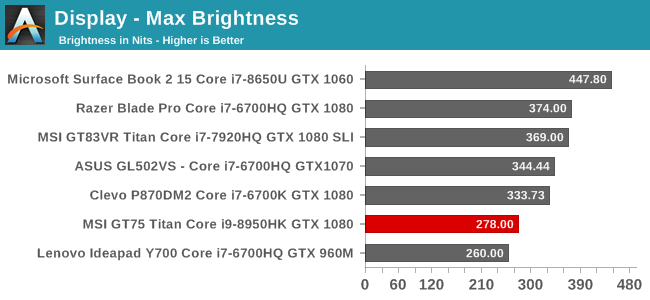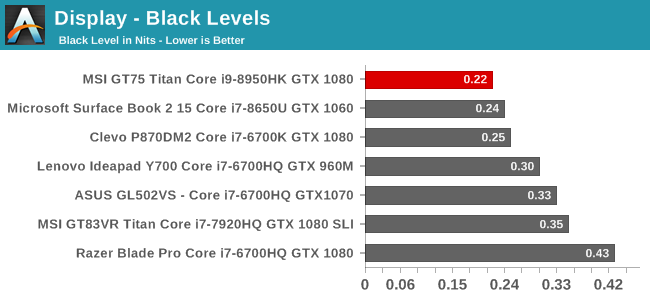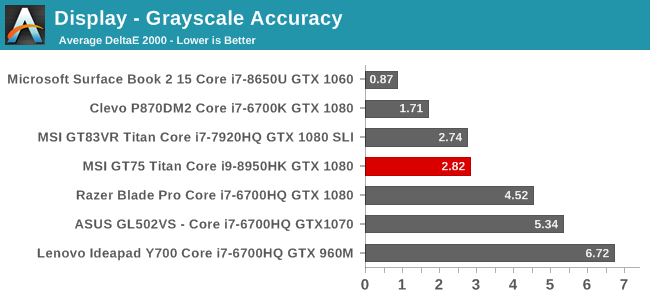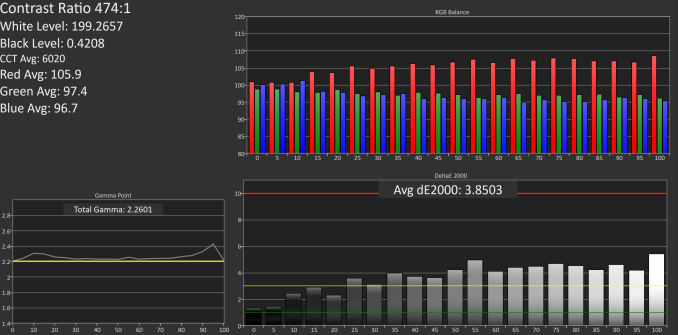The MSI GT75 Titan Laptop Review: Hex-Core DTR
by Brett Howse on September 13, 2018 9:00 AM EST- Posted in
- Laptops
- Gaming
- MSI
- Pascal
- Coffee Lake
- Coffee Lake-H
Display Analysis
MSI offers both a 1920x1080 120 Hz TN panel in the GT75 Titan, as well as a 3840x2160 IPS panel, with the higher resolution display only offering 60 Hz refresh rate. Both displays support G-SYNC.
It’s a bit odd to see a laptop with a TN display in 2018, and we’ve not tested a TN for some time. The reason for the TN though is that it’s a lot easier to make a TN panel operate at a higher refresh rate than an IPS one, as we went over in our laptop display guide.
Also, not all TN displays are equal, and the viewing angles on the GT75 Titan are much better than you’d see in a budget TN device like the HP Stream, where if you even turn your head slightly you’d see a contrast shift. The GT75 Titan offers what MSI calls a “Wide View Angle” display, and although the display doesn’t match a quality IPS, it’s pretty good.
Although the 3840x2160 IPS panel would likely be considered an upgrade, there’s a lot of merit to sticking with the 1920x1080 display in the GT75. The added refresh rate is definitely a bonus, and despite this laptop offering the fastest GPU available, even the GTX 1080 is going to struggle with gaming when being asked to push more than 8 million pixels. 1920x1080 is a bit of a sweet spot, especially at the 120 Hz refresh rate, where quite a few of our gaming tests tended to be around anyway.
To test the display we use SpectraCal’s CalMAN software suite, along with an X-Rite i1Display Pro colorimeter for brightness and contrast, and the X-Rite i1Pro 2 spectrophotometer for color accuracy readings. MSI offers several display color options in their software, which we’ll cover in a bit, but all testing was done with the laptop set in sRGB mode.
Brightness and Contrast



The GT75 Titan doesn’t get exceptionally bright at just 278 nits, but it’s not a laptop you’re ever going to use outdoors, so that’s enough for indoor use. The contrast ratio is surprisingly good for a TN display at over 1200:1. Minimum brightness is 14 nits, for those that want to use this in a dim room.
Grayscale

Out of the box, the grayscale is quite good, with an average dE2000 of under 3.0. There’s a few points on the sweep where the error level creeps above 4.0 though, so it’s not perfect, but since most manufacturers don’t do individual calibrations of displays, it’s a pretty good result. The gamma though is very high, well over the 2.2 expected. This is going to cause dark scenes to be darker than expected, which may be an issue in games where they don’t offer a built-in way to change the gamma.
Gamut

The gamut levels for the GT75 Titan actually exceed the sRGB gamut that the laptop is supposed to be targeting, which is not a good thing. It means that colors are going to be oversaturated by default, and if you calibrate, it will likely result in at least some levels of banding.
Saturation

The difference between the saturation test and the gamut test is that the gamut test only tests at the 100% levels for the primary and secondary colors, whereas the saturation sweep tests the entire range. It also makes it fairly obvious that the color not only exceed the 100% levels for sRGB, but they are also skewed off of the correct axis. The overall dE2000 level of about 4 isn’t terrible for a TN display, but it’s not close to some laptops in terms of accuracy.
Gretag Macbeth

The Gretag Macbeth test does a much wider sweep of the color spectrum, and tests colors off of the primary and secondary axis, such as skin tones. Unsurprisingly after seeing the other results, the overall error level on this display isn’t terrible, but every single color misses its target, with some of them missing by quite a bit. Several of the color tests are closing in on error levels of almost eight.
Comparator
The comparator gives you a look at the relative differences between what the display is supposed to be showing, which is the color on the bottom, and what the display is actually showing, which is the color on the top. It's a relative measurement though because any errors in your own display will change the results.
GT75 Auto Calibration
MSI has added a feature to their software suite which allows you to calibrate the display using a colorimeter. Currently it only works with the X-Rite i1Display Pro, the SpectraCal C3, or the SpectraCal C6. Although it does require some hardware, it’s nice to see this kind of an option available built right into the laptop software suite.
To see how it would do on calibrating this display, we gave it a run through using the X-Rite i1Display Pro.
Unfortunately, the built-in calibration actually made the display noticeably more red. It did fix the gamma correctly, but the red values are far higher than they should be across pretty much the entire sweep. The RGB levels were surprisingly good out of the box, and calibrating the laptop has made the situation a lot worse. If you are going to calibrate the display, you can likely use the software that comes with any of the colorimeters and get a better result.
Display Conclusion
Despite the GT75 Titan shipping with a TN display, it’s a lot better TN than most, offering pretty good viewing angles, without the massive contrast shift that’s the hallmark of TN. Although the color calibration isn’t perfect out of the box, and the display is oversaturated, this probably won’t bother much of the target demographics. It’s a bit of a shame considering the price of this device that some more effort couldn’t be put into the display at the factory, but that’s a story we are used to hearing about.
It’s also nice to see MSI include some rudimentary calibration software right in their TrueColor application. The calibration process itself only takes about 30 seconds though, and the end result is perhaps expectedly poor as a result.
However, when you look at gaming on this system, which is of course its primary function, the extra refresh rate, coupled with the G-SYNC, is very noticeable, and provides a very smooth result when coupled with the powerful GPU inside.

















48 Comments
View All Comments
ViRGE - Thursday, September 13, 2018 - link
Later on in the article, they mention that it's the new adapter based on Intel 9260, rather than the awful Qualcomm stuff. That may make it worth it. The worst part of Killer's stuff in recent years wasn't the software, it was the underlying hardware.Brett Howse - Thursday, September 13, 2018 - link
Yes the 1550 didn't exhibit any of the issues I've seen with the older model. I was pretty happy with it.PeachNCream - Friday, September 14, 2018 - link
In a roundabout way, this validates a number of complaints about earlier models of Killer Wireless products that were the subject of ire in previous articles. It's a shame that sort of acknowledgement wasn't around when previous generations were actually being sold. Also, this is the first time I've seen a Killer Wireless even get a bandwidth test in a while. Recent motherboards equipped with earlier model Killer WiFi cards didn't get any testing. I'm not trying to connect and conspiracy dots here, but the combination of facts doesn't paint a very rosy picture about the past couple years of Anandtech's view of Killer products and might add fuel to the fire of people like timecop1818 to continue to denounce Rivet Networks' claims as suspicious.Brett Howse - Friday, September 14, 2018 - link
You're mistaken I've reviewed plenty of laptops with Killer's previous model and every single time I said they had reliability issues. I think I've been pretty clear over the last couple of years that at this point there's Intel and no one else in terms of quality Wi-Fi. In fact I recently reviewed a laptop with the Qualcomm Wi-Fi that the Killer was based on and it had the exact same issues.PeachNCream - Friday, September 14, 2018 - link
That wasn't a call out of you in specific, but the tone of the site as a whole. In fact, I agree that you've noted stability problems and recommended driver updates in reviews of the Dell XPS 15 9560, the MSI GT83VR Titan 7RF, and Clevo P870DM2, and had a relatively slow result with a Razer Blade Stealth in March of 2016. (I didn't remember so I just checked and apologize for leaving you with the impression that I was slinging ire your way.)The lack of bandwidth testing is more a comment about motherboard reviews where there isn't much in the way of validation done with NIC performance, but there were some comments espousing the benefits of its presence. There have also been past product announcements that were promotional in nature. All of that was in the absence of analytical testing that proved the benefit of the Killer NIC's traffic prioritization, its key selling point. Mix that situation with the lingering ire Bigfoot/Rivet/whomever else has built over the years with customers and you've got a situation where people will get defensive or aggressive over being told they should find the product useful. None of that is something I think you've had a hand in. The problem is, or maybe was given the transition to Intel hardware and that the point is probably now moot, elsewhere.
pyrrh0 - Thursday, September 20, 2018 - link
I work with Wi-Fi and Apple's choice of Broadcom's kit in its laptops trumps anything I've used or heard about using Intel's WLAN gear.bennyg - Friday, September 14, 2018 - link
Eh, I had an issue a few years ago that was easily fixed by uninstalling the silly management software, killer wlan issues are overblown imoRedNeon - Friday, September 14, 2018 - link
Except that there already is a laptop with AMD Vega 56 GPU, the Acer Predator Helios 500.RedNeon - Friday, September 14, 2018 - link
Anandtech used to be good.Brett Howse - Friday, September 14, 2018 - link
Those were the days!